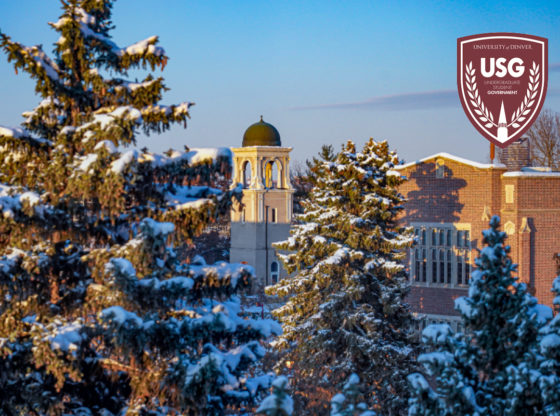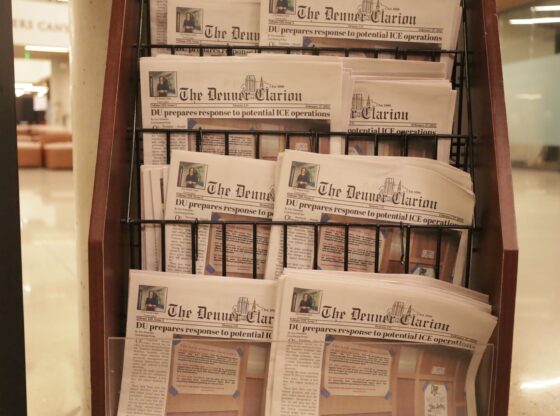DU hosted its 13th Annual Diversity Summit on May 8-10, featuring a bigger Community Night in an effort to engage citizens in the larger Denver community, according to Carolyn Ash, educational consultant and member of the Summit’s planning committee.
“Since last year, [there has been] this Thursday opening Community Night, but we really wanted that to be taken to the next level, to really get even more community participation and engagement,” said Ash.
The theme of this year’s summit was “Diversity and Inclusion in Higher Education: 150 Years of Learning, Growth and Hope.” The Diversity Summit started in 2001, spearheaded by the Undergraduate Student Association. It has now grown to include hundreds of attendees. It was expanded to a three-day format last year.
The summit kicked off on Thursday, May 8, with Community Night, extended to the Denver community as a whole. Event organizers screened the film “American Promise,” which chronicles the K-12 experience of two African-American boys in New York, and the ups and downs of their educational experience at a prestigious New York preparatory school. Ash had seen the documentary in the fall and had a chance to meet the filmmakers.
“I presented the film to the [Diversity Summit] planning committee in January. I had a feeling that the larger Denver community would be interested in it,” said Ash. “Since it was kind of K-12 focused, I was wondering how it would apply to DU, but the planning committee said ‘Absolutely, this is something people want to see here.’”
Filmmakers Joe Brewster and Michèle Stephenson, who documented the life of their son Idris and his friend Seun in the film, flew in from New York City to attend the screening.
“Education is not just about the skills. It’s about feeling welcome, of being encouraged socially and emotionally, a full participant in academics,” said Brewster.
On Friday, May 9, Diversity Summit participants had the chance to hear speeches from two keynote speakers and attend a multitude of breakout sessions.
Marybeth Gasman, professor of higher education at the Graduate School of Education at the University of Pennsylvania, delivered the summit’s opening keynote address, “Teaching Inclusive History.”
In her talk, Gasman addressed the dominance of white men in the teaching of American history.
“You can’t just teach about white men,” said Gasman. “I learned about the great white men that led American higher education, I learned about the great white men who funded American higher education, and that’s great, but you can’t only learn about that.”
She also addressed how history is typically taught, citing an emphasis on the affluent middle class and an organizational structure based around war.
“I try to turn this on its head,” said Gasman. “I realize this and I incorporate it. I want every one of my students to be able to see themselves in my syllabus. If you come up to me after class and you say, ‘I don’t see myself,’ I will either find you, or I will go out and get information that allows you to see yourself.”
Chancellor Robert Coombe spoke after Gasman, citing DU’s progress with regards to diversity and inclusion.
“As we grow more and more diverse at DU, it just becomes a fundamentally higher quality, deeper institution,” said Coombe. “The university community is a collection of very different people.”
Several breakout sessions were held in Sturm after the address, continuing into the afternoon after a luncheon in the Driscoll Center Ballroom.
Ramona Beltrán from the Graduate School of Social Work at DU delivered the luncheon’s keynote address, “Honoring Sand Creek: Healing from Legacies of Historical Trauma.”
“As many of you know, the founder of DU, John Evans, was territorial governor [of Colorado] at the time, and he was explicit about his mission to eradicate the area of native peoples,” said Beltrán, a member of the Yaqui tribe from Northern Mexico. “In August of 1864, he made a proclamation encouraging citizens go out in pursuit, kill and destroy all hostile Indians that lived west of the plains.”
According to Beltrán, on November 29, 1864, Colonel John Chivington, an ally of Evans’, led a force of 675 volunteer soldiers in an attack against several hundred Cheyenne and Arapaho, most of whom were women, children and elderly. Over 200 Native Americans were killed.
Otto Braided Hair, a descendant of the survivors of the Sand Creek Massacre and coordinator of the Sand Creek Spiritual Healing Run and Walk, said a prayer before the address began.
“It’s time for us to begin to mend the broken relationships we have with ourselves, each other and the land,” said Beltrán. “There are ways that we as an indigenous people have been making efforts of this since colonization began and we continue to do so, but the invitation is for all of you, all of those out there who experience the connection that we have as people, to join in.”
On Saturday, May 10, students from Munroe and Smith elementary schools attended the Second Annual Day of Action, where they learned about the pursuit of higher education. Over 170 families and students from Munroe attended last year, which inspired event organizers to invite Smith this year as well, according to Anthea Johnson Rooen, director of College Access and Pipeline Programs for the Center for Multicultural Excellence. About 200 families and students showed up this year between the two schools.
“[This year] we didn’t get as many students or families as we thought,” said Rooen. “For me, even though we may not have gotten as many as we did, I am certain that the students and the parents who are here are going to be really impacted.”
Rooen said this year’s summit was a little different, adding an all-Spanish Q&A session during lunchtime, as well as leading a scavenger hunt along two different routes for the elementary school students.
Katrina Yoshida, the outgoing vice president of USG, worked on the Diversity Summit two years ago and helped create the event. Julio Alas, a Munroe kindergarten teacher and DU alumnus, approached Yoshida and Rooen with the idea.
“The Diversity Summit really wanted something after having a day of learning about certain issues and how to implement it, they wanted something that was tangible, that was action,” said Yoshida.
As with last year’s Day of Action, the Diversity Summit partnered with DU Service and Change, who brought in over 100 volunteers and student presenters. DU students held several different workshops that ranged from cooking club to video production to physics.
Rooen said it is important to get the elementary school students actively involved in the sessions.
“We’re not having the students just sit and listen to lectures but we’re actually able to introduce them to what school’s about,” said Rooen.
Yoshida said since most of the elementary school students come from low-income backgrounds, it is important to show them that “college is for certain,” a phrase coined at the event last year.
“Some of these students, the idea of college was never in their heads and if you don’t start now, and if they’re in high school and you’re trying to plant the idea in them, it’s too late,” said Yoshida. “Last year afterwards you hear these students saying, ‘I want to go to DU’ and that’s the best thing.”











